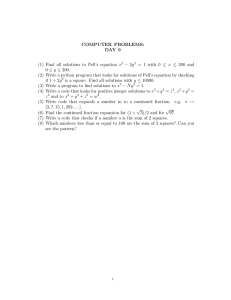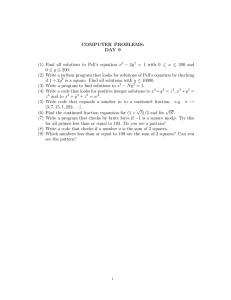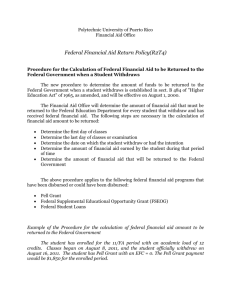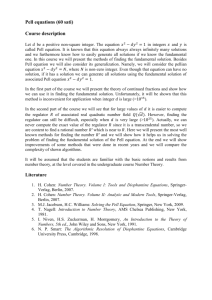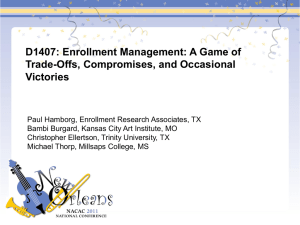Subsidizing Higher Education through Tax and Spending Programs Tax Policy Issues and Options
advertisement
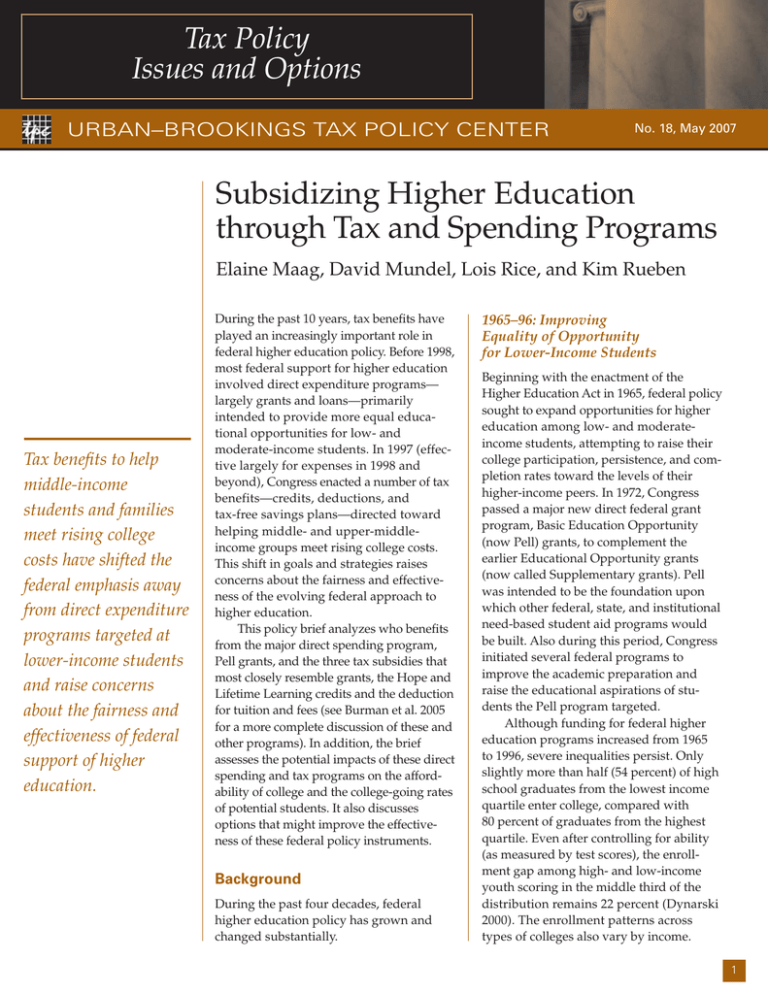
Tax Policy Issues and Options URBAN–BROOKINGS TAX POLICY CENTER No. 18, May 2007 Subsidizing Higher Education through Tax and Spending Programs Elaine Maag, David Mundel, Lois Rice, and Kim Rueben Tax benefits to help middle-income students and families meet rising college costs have shifted the federal emphasis away from direct expenditure programs targeted at lower-income students and raise concerns about the fairness and effectiveness of federal support of higher education. During the past 10 years, tax benefits have played an increasingly important role in federal higher education policy. Before 1998, most federal support for higher education involved direct expenditure programs— largely grants and loans—primarily intended to provide more equal educational opportunities for low- and moderate-income students. In 1997 (effective largely for expenses in 1998 and beyond), Congress enacted a number of tax benefits—credits, deductions, and tax-free savings plans—directed toward helping middle- and upper-middleincome groups meet rising college costs. This shift in goals and strategies raises concerns about the fairness and effectiveness of the evolving federal approach to higher education. This policy brief analyzes who benefits from the major direct spending program, Pell grants, and the three tax subsidies that most closely resemble grants, the Hope and Lifetime Learning credits and the deduction for tuition and fees (see Burman et al. 2005 for a more complete discussion of these and other programs). In addition, the brief assesses the potential impacts of these direct spending and tax programs on the affordability of college and the college-going rates of potential students. It also discusses options that might improve the effectiveness of these federal policy instruments. Background During the past four decades, federal higher education policy has grown and changed substantially. 1965–96: Improving Equality of Opportunity for Lower-Income Students Beginning with the enactment of the Higher Education Act in 1965, federal policy sought to expand opportunities for higher education among low- and moderateincome students, attempting to raise their college participation, persistence, and completion rates toward the levels of their higher-income peers. In 1972, Congress passed a major new direct federal grant program, Basic Education Opportunity (now Pell) grants, to complement the earlier Educational Opportunity grants (now called Supplementary grants). Pell was intended to be the foundation upon which other federal, state, and institutional need-based student aid programs would be built. Also during this period, Congress initiated several federal programs to improve the academic preparation and raise the educational aspirations of students the Pell program targeted. Although funding for federal higher education programs increased from 1965 to 1996, severe inequalities persist. Only slightly more than half (54 percent) of high school graduates from the lowest income quartile enter college, compared with 80 percent of graduates from the highest quartile. Even after controlling for ability (as measured by test scores), the enrollment gap among high- and low-income youth scoring in the middle third of the distribution remains 22 percent (Dynarski 2000). The enrollment patterns across types of colleges also vary by income. 1 ISSUES AND OPTIONS Lower-income college students are disproportionately enrolled in public, two-year colleges and short-term technical programs. Among the nation’s top-ranked colleges, only 3 percent of students are from the lowest income quartile, while 74 percent are from the top quartile (Sawhill 2006). Further, the persistence and completion rates of lower-income college students remain significantly below those of others. Several factors may contribute to the elusiveness of equality of higher education opportunity for lowincome students. These factors include rising college list prices (tuition and fee charges), which disproportionately affect lower-income students and families (Hauptman and Rice 1997); weaknesses in the K–12 education system for these students; possible differences in their educational aspirations; inadequacies in funding levels and the limited predictability of the Pell awards and other grants; and poor program design and operations. 1997–2006: Additional Policy Goals and Instruments Adopted In 1997, in response to rising college prices that many policymakers and analysts believed were constraining the college enrollment and choices of middle-income students, President Clinton proposed and Congress enacted a new form of aid to college students and their families: higher education tax benefits. These included the Hope credit and the Lifetime Learning credit (LLC), the tuition and fees deduction, incentives for savings set aside for future college costs (Coverdell accounts and 529 plans), and deductions for interest payments on student loans after college. Following their passage, federal support for the tax incentives grew 2 Urban–Brookings Tax Policy Center rapidly. At the same time, federal support for traditional, direct expenditure programs supporting college students and their families (particularly the Pell grant program) also grew significantly, but somewhat more slowly. Between academic years 1997–98 and 2005–06, total federal assistance to college students and their families grew 76 percent, from $54 billion to $94 billion (2005$). During this time, federal tax benefits for students and their parents increased dramatically, from $0 in 1997–98 to roughly $6 billion in 2005–06; federal support for grants to undergraduates (excluding veterans and military programs) also grew, increasing 59 percent from $8.5 billion to $13.5 billion (The College Board 2006). Major Federal Tax Benefit and Direct Grant Programs The major federal tax benefit and direct grant programs are the Hope and Lifetime Learning credits, the tuition and fees deduction, and the Pell grant program. Hope and Lifetime Learning Credits In 2005, the Hope credit provided a benefit of up to $1,500 for first- and second-year students enrolled at least half-time in degree credit programs. In 2006, the credit (which is indexed) rose to a maximum of $1,650. To qualify for the maximum Hope credit in 2006, a student’s tuition and fees must be at least $2,200. Students and their families received approximately $3.5 billion in tax relief from the Hope credit in 2005 (U.S. Census Bureau 2006). The LLC provides up to $2,000 for training and coursework for students, regardless of their year in college or whether they are in a degree credit program. To receive the full LLC, students or their parents must pay at least $10,000 in tuition and required fees. In 2005, the LLC program provided approximately $2.2 billion in tax relief to students and their families. The two tax credits are similar in important ways. Both the Hope credit and LLC are nonrefundable, so the resulting benefits cannot exceed taxes owed. In addition, the maximum benefit amounts from both credits phase out between adjusted gross income (AGI) of $45,000 and $55,000 ($90,000 and $110,000 for married couples). The two tax credits differ in an important way—the Hope credit is a per student credit, while the LLC is per tax return. If a family has more than one student in college, each qualifying student may receive a Hope credit. In contrast, all students in a family receiving an LLC must pool their expenses together to determine the family’s LLC. Each student may receive only one credit, though a family with more than one student may receive both credits. Tuition and Fees Deduction The tuition and fees deduction allows parents or students who pay tuition and fees to reduce their taxable income by up to $4,000. These limits apply to all students in the family. Unlike most other deductions, taxpayers need not itemize deductions to receive this benefit. The tuition and fees deduction provided approximately $1.9 billion in tax relief in 2005 (U.S. Census Bureau 2006). The value of the tuition and fees deduction depends on a person’s marginal tax rate. The maximum value for a single person in the lowest tax bracket (10 percent) is $200. Because persons and families in higher brackets pay higher marginal tax rates, these taxpayers benefit more from the tuition and fees deduction. To qualify for the deduction in Urban–Brookings Tax Policy Center 2006, a family’s AGI cannot exceed $80,000 for single filers or $160,000 for married filers. The Pell Grant Program The Pell Grant program provided approximately $12.7 billion in grants to students in academic year 2005– 06. Students receive a grant based on the maximum amount (currently $4,050) minus their expected family contribution (EFC). The EFC is determined by a complex formula based on parental and student income from all sources; student and parental savings (excluding retirement savings); assets for families whose income exceeds $50,000 (excluding home assets and assets for businesses employing fewer than 100 workers); family size; and the number of family members attending college. Students who qualify for a grant between $200 and $400 receive a $400 grant. Students with a calculated award falling below $200 receive no Pell grant. Similarities among the Tax Benefit and Grant Programs For each program, the amount received does not have to be repaid— thus, the tax benefits, like the Pell awards, are effectively grants. Neither the Pell nor the tax programs provide information about likely award levels before students and parents make many important collegegoing decisions. As noted earlier, Pell grant award levels become known a few months before enrollment, and the benefits from tax credits and deductions become known after enrollment has occurred, expenses have been paid, and taxes calculated. Further, the complexity of each program adds to the difficulty of predicting likely award levels. The complexity of the tax programs stems primarily from programs’ complicated regulations embedded in the ISSUES AND OPTIONS already-daunting tax code and the interactions between the tax programs and state and institutional financial aid programs, which reduce the college costs that enter the tax benefit calculations (the costs students and their families actually pay). Complexity in the Pell program arises primarily because of the large number of questions (in excess of 100) included in the Free Application for Federal Student Aid (FAFSA) to determine a student’s EFC. Much of the information on the FAFSA duplicates information provided on tax returns. All four programs consider family income, but the definition of income used in the tax and Pell programs differs, as does the way in which income affects the recipient’s benefits. The tax and spending programs also interact with each other. Although the benefit determination criteria of the three tax benefits may indicate that a tax filer can receive more than one of them, a student’s expenses may only be used to qualify for one benefit. Pell and other grant aid reduce expenses qualifying for the tax programs. Because a student could benefit from more than one program (i.e., targeted populations have significant overlaps), these interactions among the programs affect who receives benefits and the pro- grams’ effectiveness. Evidence from a recent study indicates that students and their families have difficulty deciding which program provides them with the greatest benefit, thus frequently failing to claim the optimal tax benefit (GAO 2005). The Impact of the Increasing Role of Higher Education Tax Benefits Changes in federal support for higher education over the past decade raise two questions: who benefits from the different programs, and has the changing mix of benefits altered student college-going choices and behaviors? The Changing Distribution of Tax and Direct Grant Benefits The creation of tax benefits has meant more benefits for middle-income families.1 (See table 1.)2 While almost all Pell grants go to low- and moderateincome students, less than half the tax benefits assist this group. In part, this is because independent students (generally students who are over 24 years old and who file their own tax returns) have lower income, and thus have little tax liability against which to claim the credit or deduction benefits. On the other hand, independent students receive more TABLE 1. Distribution of Federal Tax and Grant Programs, 2005 (percent, unless noted) Cash income category < $30,000 $30,000–50,000 $50,000–100,000 > $100,000 Total benefits ($1,000s) Hope LLC Tuition and fees deduction Hope, LLC, or deduction 15 25 53 7 25 29 41 5 8 10 28 53 19 25 42 14 $2,286 $3,987 $1,228 $7,501 Pell program 85 14 1 –a $13,149 Sources: Urban–Brookings Tax Policy Center Microsimulation Model (version 0304-5); Pell information supplied by Department of Education based on program data and family income. Notes: Tax units with negative cash income are excluded from the lowest income class but are included in the totals. Benefits may not sum to given totals because of rounding. a. Pell program data group all units with family income greater than $60,000. These data are displayed in the $50,000–$100,000 category. 3 Urban–Brookings Tax Policy Center ISSUES AND OPTIONS than half of all Pell awards. Since the Hope and LLC are nonrefundable, lower-income families do not benefit because they do not owe any income tax. High-income families largely do not benefit from the tax credits because eligibility for them phases out. Tax benefits disproportionately go to higher-income families (table 2). Almost half of families with incomes below $30,000 benefit from the Pell program, while less than one-third of such families receive a tax benefit. At the same time, almost three-quarters of the middle- and upper-middleincome units receive tax benefits, and only 3 percent of the students in these units receive Pell awards. Over half of families with students benefit from the Hope, LLC, or the tuition and fees deduction. Fewer families benefit from the Hope credit than the other tax programs, reflecting its more stringent eligibility rules. A little over a quarter of students receive a Pell grant. Table 3 shows average benefits received from the various programs. In all income categories, except the highest income bracket, the average Pell benefit received exceeds the average tax benefit. Very few students in the highest bracket receive a Pell, but those that do tend to receive substantial awards. Table 3 also shows the different ways income enters the award-level determination process of the tax and direct expenditure programs and how the nonrefundable nature of the tax benefits affects the pattern of awards among different types of recipients. The role of income in the Pell program EFC formula creates the well-targeted pattern of Pell awards among recipients from different family income groups, while the nonrefundability of the tax benefit reduces the average awards among lower-income beneficiaries. For some families receiving benefits through the tax system, the amount of assistance can be substantial; but, on average, the tax programs provide relatively modest benefits, an average of $771. Average benefits are highest for those receiving only a Hope credit ($1,069), followed by the LLC ($978), and finally the tuition and fees deduction ($314). Families TABLE 2. Tax Units with Students (1,000s) and Percentage of Units with Students Receiving Benefits, 2005 Cash income category < $30,000 $30,000–50,000 $50,000–100,000 > $100,000 Total Hope LLC Tuition and fees deduction Hope, LLC, or deduction Pell program 392 (4.6%) 524 (13.8%) 1,004 (21.9%) 218 (9.7%) 1,238 (14.4%) 1,114 (29.4%) 1,552 (33.8%) 173 (7.6%) 1,134 (13.2%) 528 (13.9%) 1,059 (23.1%) 1,187 (52.5%) 2,724 (31.8%) 2,097 (55.3%) 3,401 (74.1%) 1,507 (66.6%) 4,141 (48.3%) 1,032 (27.2%) 136 (3%) –a 2,138 (11.1%) 4,077 (21.1%) 3,908 (20.2%) 9,729 (50.4%) 5,308 (27.5%) Sources: Urban–Brookings Tax Policy Center Microsimulation Model (version 0304-5); Pell information supplied by Department of Education based on program data and family income. Notes: Tax units with negative cash income are excluded from the lowest income class but are included in the totals. Benefits may not sum to given totals because of rounding. For a description of cash income, see http://www.taxpolicycenter.org/TaxModel/income.cfm. Percentages of units with benefits appear in parentheses. a. Pell program data group all units with family income greater than $60,000. These data are displayed in the $50,000–100,000 category. 4 with incomes between $30,000 and $100,000 receive, on average, the largest tax benefits. Participation in Hope, LLC, Tuition and Fees Deduction, and Pell Grant Programs An important determinant of the distributions of benefits resulting from the various tax and direct grant programs is the participation rates of potentially eligible students and families. As with almost all tax and transfer programs, not everyone eligible receives a benefit. Reasons for this include confusion surrounding the interactions of the programs (for a discussion, see Davis 2002 and GAO 2005) and complexity—both in filling out the additional tax form required to receive a tax benefit and the FAFSA required of Pell applicants. Still further complexity is associated with having to decide how the programs interact and which benefits to claim. Our estimates suggest that approximately two-thirds of families eligible for either the Hope or LLC actually receive it, and participation rates tend to rise with income (Burman et al. 2005). Similarly, most dependent students from families with incomes below $20,000 would likely have received large, if not maximum, Pell grants if they had applied, but only about three-quarters filed the required FAFSA in 2003–04 (King 2006). The Impact of Federal Higher Education Tax Benefits and Direct Grants on College Affordability At first glance, the impact of federal tax benefits and grants on college affordability appears relatively clear: tax benefits and grants provide resources that reduce the need for students and parents to finance college with their own resources. Of concern is the notion that colleges, particularly those with tuition below Urban–Brookings Tax Policy Center ISSUES AND OPTIONS TABLE 3. Average Benefit per Family Receiving Benefits, 2005 ($) Cash income category Hope LLC Tuition and fees deduction Hope, LLC, or deductiona Pell program < $30,000 $30,000–50,000 $50,000–100,000 > $100,000 866 1,098 1,202 751 793 1,047 1,051 1,202 90 238 329 550 523 891 937 680 2,707 1,731 1,132 –b Total 1,069 978 314 771 2,477 Sources: Urban–Brookings Tax Policy Center Microsimulation Model (version 0304-5); Pell information supplied by Department of Education based on program data and family income. Notes: Tax units with negative cash income are excluded from the lowest income class but are included in the totals. Benefits may not sum to given totals because of rounding. For a description of cash income, see http://www.taxpolicycenter.org/TaxModel/income.cfm. a. Families with more than one student may receive more than one tax benefit. For these families, the combined benefit is shown. b. Pell program data group all units with family income greater than $60,000. These data are displayed in the $50,000–100,000 category. the maximum amount subsidized by the credits, could respond by increasing their tuition at little cost to students receiving the credits. Unfortunately, this would mean a price increase for students who do not receive the credit, among them the low-income students who do not benefit from nonrefundable credits. Little evidence shows that this has happened. In addition, the tax benefits may have little impact on perceived changes in affordability given the lack of connection between the college payment and tax filing processes. The Impact of Federal Higher Education Tax Benefits and Direct Grants on College Attendance Studies of grant programs suggest that those that are well targeted (i.e., programs directed toward lower-income, more price-sensitive students) and have more predictable and larger awards (i.e., large relative to college prices) tend to have larger impacts on collegegoing rates. In addition, relatively simple, easy-to-understand, and extensively and effectively publicized programs have generally been more effective.3 Neither the tax benefits nor the Pell program possess the characteristics of these more effective programs. The complexity of both makes it difficult for families to anticipate the benefits they will receive. To estimate the benefits of a particular tax policy, both eligible expenses and anticipated aid awards need to be known. Even after a period of enrollment, the tax return must be completed in order to know the final tax rates and tax amounts that determine the value of potential credits or deductions related to college going. On the flip side, everyone who qualifies for and applies for an education credit receives it. Poor targeting may also cause tax programs to have little, if any, impact on college attendance. Small changes in college prices appear to have little, if any, effect on middle- and higherincome families; lower-income students who are more price sensitive would also be unaffected by the tax programs, because they are generally ineligible (Congressional Budget Office 2000). Researchers using a microsimulation model found no evidence of increased enrollment three years after the education tax credits were enacted, although the credits appeared to cause a slight increase in the proportion of students age 20 to 24 attending four-year institutions (Long 2003). The targeting of the Pell program on more price-responsive lower- and moderate-income students enables it to have somewhat greater influence on college attendance, but this impact has been difficult to observe in commonly reported enrollment data. The Pell program may be more readily understood and thus more effective than programs embedded within the complex tax code. However, the level of the award is somewhat unpredictable in that it is limited by annual appropriations. Improving the Effectiveness of the Tax Benefit Programs Policymakers could simplify the rules of the two credits so all degreeseeking students would benefit most from one credit, rather than needing to choose between the Hope and the LLC. One proposal for doing this, the College Opportunity Tax Credit (COTC), would increase the maximum credit to $2,500.4 The credit would provide a 100 percent credit for the first $1,000 of qualified expenses and a 50 percent credit for the next $3,000 of qualified expenses. Unlike the Hope, the COTC would not require that the student be in the first two years of school. This would leave the LLC directed to only non– degree-seeking students, maintaining its current rules. A further simplification would be to eliminate the tuition and fees deduction and the LLC. This would eliminate overlap in the inschool tax subsidies, but it would mean the elimination of subsidies for continuing education. We estimate the incremental cost of the COTC in 2005 would have been $1.9 billion. All students who previously benefited from the Hope would benefit from the COTC, and some students who took either the LLC or the tuition and fees deduction would stop taking those tax benefits 5 Urban–Brookings Tax Policy Center ISSUES AND OPTIONS and instead switch to the COTC. The pattern of benefits for COTC recipients is similar to the current tax benefits. Families with income between $50,000 and $100,000 receive the largest share of benefits—and the highest average benefit as well (table 4). Making the COTC refundable would direct more benefits to lowerincome students but at substantial cost in terms of tax expenditures and integrity in the tax system. Many more students and their families would be eligible to receive the credit, and some already receiving the credit would receive a larger credit. We estimate this proposal would have increased the incremental cost from $1.9 billion to $7.8 billion in 2005. Benefits under a refundable COTC would be more directed toward lower-income students. Those with incomes below $30,000 would qualify for almost half the benefits, rather than the 14 percent of benefits they qualify for under the nonrefundable COTC proposal (see table 4). Making these credits refundable would impose increased complexity on families not currently required to file a return; they would be required to do so for the sole purpose of claiming an education credit. If this added complexity limited the number of new filers, many of the filing units that refundable credits target would not receive the predicted benefits. Understanding these trade-offs requires further research, but the new complexity may suggest that putting additional resources into more traditional, direct student grant programs would be more appropriate. Improving the Effectiveness of the Pell Program Simplifying the FAFSA could reduce the complexity of the Pell grant’s application process and improve its efficacy. For example, a student’s EFC could depend largely on the student’s or student’s parents’ AGI, as reported on the preceding year’s tax return (though this approach would ignore different family needs currently captured in the FAFSA). For applicants not required to file a tax return, a surrogate of income such as a W-2 form could be used. Many nonfilers (i.e., students from families who receive several forms of public assistance) are categorically eligible for the maximum Pell award, and documentation of such benefits could replace the current FAFSA—eliminating the need for them to answer dozens of questions. This simplification would eliminate consideration of parental and student assets, but assets have little impact on the EFC for a majority of Pell-eligible TABLE 4. Number of Students Receiving Benefits, Amount, and Share of Benefits under Proposed College Opportunity Tax Credit (COTC) Nonrefundable COTC Units receiving benefits (1,000s) Average benefits ($) < $30,000 $30,000–50,000 $50,000–100,000 > $100,000 752 1,088 1,857 227 1,102 1,526 1,797 1,064 Total 3,924 1,546 Cash income category Share of benefits (%) 13.6 27.4 55.0 3.98 100 Refundable COTC Units receiving benefits (1,000s) Average benefits ($) 3,223 1,353 1,912 233 1,909 1,905 1,892 1,092 6,761 1,874 Source: Urban–Brookings Tax Policy Center Microsimulation Model (version 0304-5). 6 Share of benefits (%) 48.6 20.4 28.6 2.0 100 applicants (Dynarski and ScottClayton 2006). Another option for increasing the efficacy of the Pell program would be to target the neediest students for any proposed increases in the Pell maximum award. Current proposals include increasing the maximum grant, but whenever this happens, new categories of higher-income students— usually those above $40,000—become automatically eligible for the minimum Pell award of $400. One way of targeting lower-income students would be to eliminate all small awards—for example, those below $500 (or alternatively the current $400 minimum award)—by changing the formula used in calculating the EFC or the statute so all recipients whose calculated award is less than $500 would not receive a Pell award. This change would also reduce the overlap between the Pell program and the tax credits and reduce the share of the Pell program budget going to awards that are too small to influence college-going behaviors. Conclusion Historically, the role of federal higher education policy has been to use direct expenditures to provide more equal opportunities for the neediest students. The introduction of the tax benefits changed this, since the benefits do not go toward low-income families. Instead, they subsidize college attendance of middle-income students and appear to have little effect on attendance decisions. Both the Pell program and the tax benefits could benefit from simplification efforts and more direct targeting of low-income families. These changes could improve the ability of the programs to increase attendance of lower-income students while limiting subsidies for students likely to attend without a subsidy. As the brief emphasizes, the resolution of these policy issues is made Urban–Brookings Tax Policy Center far more complicated by the lack of strong research-based evidence regarding the effectiveness of the current grant and tax policy instruments and alternatives. Congressional Budget Office. 2000. “An Economic Analysis of the Taxpayer Relief Act of 1997.” Washington, DC: Congressional Budget Office. Notes Dynarski, Susan. 2000. “Hope for Whom? Financial Aid for the Middle Class and Its Impact on College Attendance.” Working Paper 7756. Cambridge, MA: National Bureau of Economic Research. 1. Unless otherwise specified, we use income to mean “cash income.” Cash income includes most forms of earned income, unearned income, transfer payments, and the employer and employee shares of payroll taxes. For a complete description as well as a comparison with other definitions of income, see http://www.taxpolicycenter. org/TaxModel/income.cfm and “Income Breaks for Distribution Tables, 2001–2015, Adjusted Gross Income” at http://taxpolicy center.org/TaxModel/tmdb/TMTemplate. cfm?DocID=574. A comparison of the distributions of tax units by AGI and cash income can be seen in table T05-0118 at http:// www.taxpolicycenter.org. The TPC definition of cash income produces results quite similar to the definition of “total income” employed in the National Postsecondary Student Aid Study. 2. In the tables in this report, students who are still considered dependents on their parents’ tax returns are included in an income category based on their parents’ income. Students who no longer qualify as dependents on their parents’ tax return (generally older students) and who receive credits, claim deductions, and/or receive Pell awards are included in an income category based on their own and their spouses’ (if married) incomes. 3. See, for example, Heller (1997), Dynarski (2002), Turner and Seftor (2002), and Long (2003). 4. Variations of this proposal came up during the 2004 presidential primary. References Burman, Leonard E., Elaine Maag, Peter Orszag, Jeffrey Rohaly, and John O’Hare. 2005. “The Distributional Consequences of Federal Assistance for Higher Education: The Intersection of Tax and Spending Programs.” Tax Policy Center Discussion Paper 26. Washington, DC: The Urban Institute. The College Board. 2006. “Trends in Student Aid, 2006.” Washington, DC: The College Board. Davis, Albert J. 2002. “Choice Complexity in Tax Benefits for Higher Education.” National Tax Journal 55(3): 509–38. ———. 2002. “The Consequences of Merit Aid.” Working Paper 9400. Cambridge, MA: National Bureau of Economic Research. Dynarski, Susan, and Judith E. Scott-Clayton. 2006. “The Feasibility of Delivering Aid for College through the Tax System.” National Tax Association Annual Conference, November 17, Boston. Government Accountability Office (GAO). 2005. “Student Aid and Postsecondary Tax Preferences: Limited Research Exists on Effectiveness of Tools to Assist Students and Families through Title IV Student Aid and Tax Preferences.” Washington, DC: GAO. Hauptman, Arthur, and Lois Rice. 1997. “Coordinating Financial Aid with Tuition Tax Benefits.” Policy Brief 28. Washington, DC: The Brookings Institution. Heller, Donald E. 1997. “Student Price Response in Higher Education: An Update to Leslie and Brinkman.” Journal of Higher Education 68(6): 624–59. King, Jacqueline E. 2006. “Missed Opportunities Revisited.” Washington, DC: American Council on Education. Long, Bridget Terry. 2003. “The Impact of Federal Tax Credits for Higher Education Expenses.” Working Paper 9553. Cambridge, MA: National Bureau of Economic Research. Sawhill, Isabel. 2006. “Opportunity in America: The Role of Education.” Washington, DC: The Brookings Institution. Turner, Sarah E., and Neil S. Seftor. 2002. “Back to School: Federal Student Aid Policy and Adult College Enrollment.” The Journal of Human Resources 37(2): 336–52. U.S. Census Bureau. 2006. “The 2006 Statistical Abstract: The National Databook.” Tax Expenditures Estimates Relating to Individual and Corporate Income Taxes, by Selected Function. Washington, DC: U.S. Census Bureau. http://www.census.gov/ prod/2004pubs/04statab/fedgov.pdf. ISSUES AND OPTIONS About the Authors Elaine Maag is a research associate with the Urban Institute’s Income and Benefits Policy Center and the Urban–Brookings Tax Policy Center. Her current research interests include state fiscal policies, tax policies for lowincome families, and disability policy. David Mundel is an independent consultant and researcher whose current work focuses on assessing and developing strategies for improving the impact of equality-ofopportunity-oriented higher education policies. Lois Rice is the Miriam Carliner Guest Scholar in the Economic Studies program at the Brookings Institution. At Brookings and previously as vice president of the College Board, she has devoted her studies and efforts to improving higher education opportunities for the neediest students. Kim Rueben is a senior research associate with the Urban Institute’s Income and Benefits Policy Center and the Tax Policy Center, where she directs the state policy effort. She also researches education finance issues and is on the board of the American Education Finance Association. 7 THE URBAN INSTITUTE Nonprofit Org. U.S. Postage PAID Permit No. 8098 Ridgely, MD 2100 M Street, NW Washington, DC 20037 Address Service Requested To order additional copies of this publication, call 202-261-5687 or visit our online bookstore, http://www.uipress.org. THE BROOKINGS INSTITUTION 1775 Massachusetts Avenue, NW Washington, DC 20036 Phone: 202-797-6000 Fax: 202-797-6004 http://www.brookings.edu THE TAX POLICY CENTER The Tax Policy Center (TPC) aims to clarify and analyze the nation’s tax policy choices by providing timely and accessible facts, analyses, and commentary to policymakers, journalists, citizens, and researchers. TPC’s nationally recognized experts in tax, budget, and social policy carry out an integrated program of research and communication on four overarching issues: fair, simple, and efficient taxation; long-term implications of tax policy choices; social policy in the tax code; and state tax issues. A joint venture of the Urban Institute and the Brookings Institution, the TPC receives support from a generous consortium of funders, including the Annie E. Casey Foundation, Brodie Price Fund at the Jewish Community Foundation of San Diego, Charles Stewart Mott Foundation, Ford Foundation, George Gund Foundation, Lincoln Institute of Land Policy, Lumina Foundation for Education, The John D. and Catherine T. MacArthur Foundation, Sandler Family Supporting Foundation, Stoneman Family Foundation, and other private and anonymous donors. The views expressed do not necessarily reflect those of the Urban Institute, the Brookings Institution, their boards of trustees, or their funders. http://www.taxpolicycenter.org THE URBAN INSTITUTE 2100 M Street, NW Washington, DC 20037 Copyright © 2007 Phone: 202-833-7200 Fax: 202-467-5775 http://www.urban.org Permission is granted for reproduction of this document, with attribution to the Urban Institute. The authors are grateful to Greg Leiserson for modeling work, Len Burman, John O’Hare, Peter Orszag, and Jeffrey Rohaly for work on earlier related projects, and Sandy Baum, David Longanecker, and Roberton Williams for comments on this brief. Errors that remain are the authors’.
